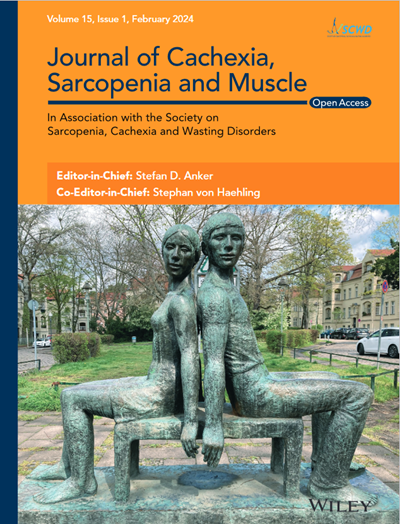在培养的肌管和小鼠模型中,CXCL14促进骨骼肌质量生长,减轻脂多糖和地塞米松诱导的肌肉萎缩
IF 9.1
1区 医学
引用次数: 0
摘要
骨骼肌质量受源自肌纤维和肌驻留细胞的分泌因子的调节。识别这些因素并了解其机制对于对抗肌肉萎缩疾病至关重要。本实验研究了CXCL14在调节肌肉质量中的作用,CXCL14是一种主要由肌肉中的纤维脂肪生成祖细胞(FAPs)分泌的趋化因子。方法本研究于2020年8月至2025年6月在韩国Soonchunhyang医学生物科学研究所(SIMS)进行。用重组CXCL14处理小鼠C2C12肌管和人原代肌管,用或不用Rps6kb1 siRNA、脂多糖(LPS)或地塞米松(DEX)共处理。测量肌管质量指数(MMI)。Western blotting检测AKT‐S6激酶(S6K)、FOXO‐Atrogin‐1/MuRF‐1信号组分和MyHCs的表达。采用8周龄雄性小鼠:ICR小鼠进行电穿孔实验,C57BL/6N菌株进行LPS和DEX萎缩模型。Cxcl14表达质粒在LPS或DEX处理或不处理的情况下电穿孔至胫骨前肌(TA)。测量肌纤维横截面积(CSA);Western blotting和RNA测序分析分子反应。统计分析包括采用Tukey事后检验的单因素方差分析,采用Dunnett事后检验的重复测量方差分析,采用Dunn事后检验的Kruskal-Wallis检验和unpaired Student t检验(视情况而定)。结果scxcl14诱导C2C12源性肌管肥大:(MMI [μm2]: 100 ng/mL CXCL14, 1345±50.97 [95% CI: 1237 ~ 1453],与对照组相比,897.9±33.33 [95% CI: 829.8 ~ 996], p≤0.0001)。小鼠TA肌肉中Cxcl14过表达显著增加肌肉质量:(CSA [μm2]: HA‐Cxcl14: 1408±15.42 [95% CI: 1378-1438]; Cxcl14‐Myc: 1499±17.18 [95% CI: 1464-1534];对照:870.1±11.25 [95% CI: 848.1-892.2], p≤0.0001)。在体外和体内模型中,CXCL14激活AKT‐S6K通路,抑制FOXO‐Atrogin‐1/MuRF‐1通路。CXCL14有效逆转LPS和DEX诱导的C2C12肌管和TA肌萎缩,MMI和CSA相应增加(均p≤0.0001)。CXCL14还促进体外原代人肌管肥大(MMI [μm2]: 100 ng/mL CXCL14, 3481±242.6 [95% CI: 2973 ~ 3989]与对照组相比,2549±114.7 [95% CI: 2310 ~ 2787], p≤0.001),显著逆转LPS和DEX诱导的萎缩(p≤0.01 ~ p≤0.0001),同时激活蛋白质合成和抑制蛋白质降解途径。结论我们的研究结果确定了CXCL14是骨骼肌质量的一种新的调节因子,并强调了其在预防或逆转人类与衰老和疾病相关的肌肉萎缩方面的治疗潜力。本文章由计算机程序翻译,如有差异,请以英文原文为准。
CXCL14 Promotes Skeletal Muscle Mass Growth and Attenuates Lipopolysaccharide‐ and Dexamethasone‐Induced Muscle Atrophy in Cultured Myotubes and Mouse Models
BackgroundSkeletal muscle mass is regulated by secretory factors derived from myofibers and muscle‐resident cells. Identifying these factors and understanding their mechanisms is critical for combating muscle wasting disorders. This experimental study investigates the role of CXCL14, a chemokine primarily secreted by fibro‐adipogenic progenitors (FAPs) residing in muscle, in regulating muscle mass.MethodsThis study was conducted at the Soonchunhyang Institute of Medi‐bio Science (SIMS), South Korea, between August 2020 and June 2025. Mouse C2C12 myotubes and primary human myotubes were treated with recombinant CXCL14, with or without co‐treatment using Rps6kb1 siRNA, lipopolysaccharide (LPS) or dexamethasone (DEX). Myotube mass index (MMI) was measured. Expression of AKT‐S6 kinase (S6K), FOXO‐Atrogin‐1/MuRF‐1 signalling components and myosin heavy chains (MyHCs) was assessed via Western blotting. Eight‐week‐old male mice were used: ICR mice for electroporation experiments and C57BL/6N strain for LPS and DEX atrophy models. Cxcl14 expression plasmids were electroporated into tibialis anterior (TA) muscles, with or without LPS or DEX treatment. Cross‐sectional area (CSA) of myofibers was measured; Western blotting and RNA sequencing were used to analyse molecular responses. Statistical analyses included one‐way ANOVA with Tukey's post hoc test, repeated‐measures ANOVA with Dunnett's post hoc test, Kruskal–Wallis test with Dunn's post hoc test and unpaired Student's t ‐test, as appropriate.ResultsCXCL14 induced hypertrophy in C2C12‐derived myotubes: (MMI [μm2 ]: 100 ng/mL CXCL14, 1345 ± 50.97 [95% CI: 1237–1453], vs. control, 897.9 ± 33.33 [95% CI: 829.8–996], p ≤ 0.0001). Cxcl14 overexpression in mouse TA muscles significantly increased muscle mass: (CSA [μm2 ]: HA‐CXCL14: 1408 ± 15.42 [95% CI: 1378–1438]; CXCL14‐Myc: 1499 ± 17.18 [95% CI: 1464–1534]; control: 870.1 ± 11.25 [95% CI: 848.1–892.2], p ≤ 0.0001). CXCL14 activated the AKT‐S6K pathway and inhibited the FOXO‐Atrogin‐1/MuRF‐1 pathway in both in vitro and in vivo models. CXCL14 effectively reversed LPS‐ and DEX‐induced atrophy in both C2C12 myotubes and TA muscles, as demonstrated by corresponding increases MMI and CSA (all p ≤ 0.0001). CXCL14 also promoted hypertrophy in primary human myotubes in vitro (MMI [μm2 ]: 100 ng/mL CXCL14, 3481 ± 242.6 [95% CI: 2973–3989] vs. control, 2549 ± 114.7 [95% CI: 2310–2787], p ≤ 0.001) and significantly reversed atrophy induced by LPS and DEX (p ≤ 0.01 to p ≤ 0.0001), accompanying the activation of protein synthesis and inhibition of protein degradation pathways.ConclusionsOur findings identify CXCL14 as a novel regulator of skeletal muscle mass and highlight its therapeutic potential in preventing or reversing muscle atrophy associated with ageing and diseases in humans.
求助全文
通过发布文献求助,成功后即可免费获取论文全文。
去求助
来源期刊

Journal of Cachexia, Sarcopenia and Muscle
Medicine-Orthopedics and Sports Medicine
自引率
12.40%
发文量
0
期刊介绍:
The Journal of Cachexia, Sarcopenia, and Muscle is a prestigious, peer-reviewed international publication committed to disseminating research and clinical insights pertaining to cachexia, sarcopenia, body composition, and the physiological and pathophysiological alterations occurring throughout the lifespan and in various illnesses across the spectrum of life sciences. This journal serves as a valuable resource for physicians, biochemists, biologists, dieticians, pharmacologists, and students alike.
 求助内容:
求助内容: 应助结果提醒方式:
应助结果提醒方式:


